18 Types of Microgreens You Can Grow Yourself (With Pictures)
-

- Last updated:
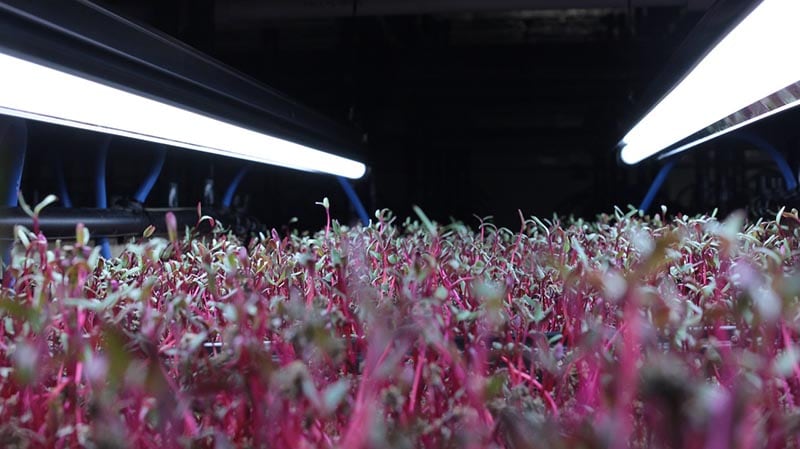
Did you know that young seedlings of vegetables and legumes are beneficial to eat? These are known as microgreens and are ready to harvest when the plant has two to four “true” leaves.
Microgreens are tender, flavorful, and easy to grow at home. The best place to grow them is indoors where there’s ample protection from the elements. All you need is a growing tray, container, or pot to get started. These are rich in different kinds of nutrients that include vitamins and minerals as well. Below, we look at some of the microgreens that you can easily grow by yourself.
The 18 Types of Microgreens
1. Alfalfa Microgreens
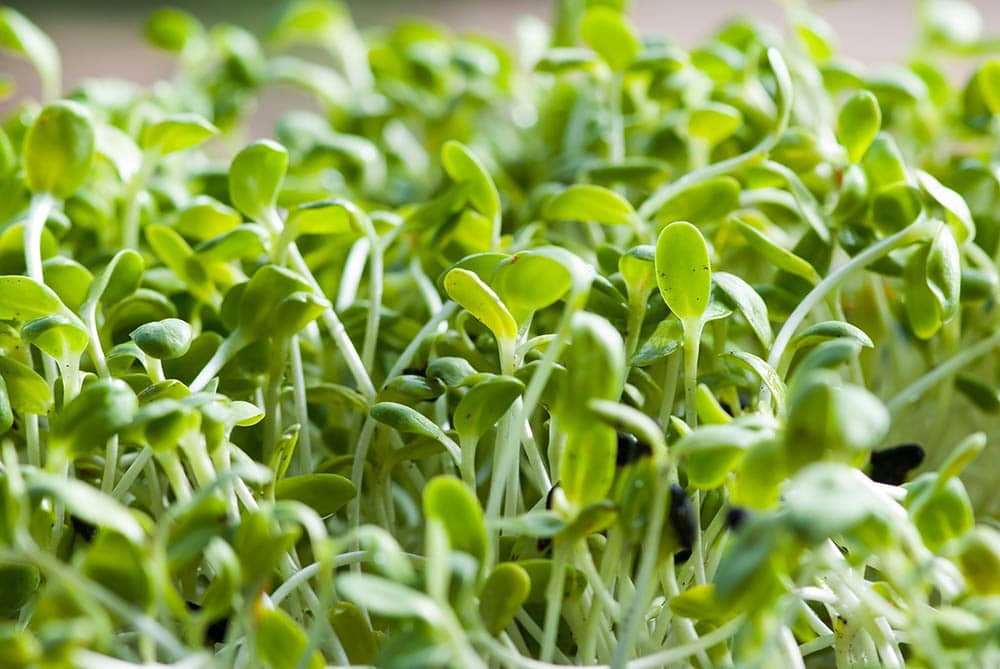
| Family: | Fabaceae |
| Germination Time: | 6 days |
| Harvest Time: | 10–14 days |
Alfalfa has been around for centuries and is one of the easiest microgreens to grow at home. They are an excellent option when you want to enjoy a mild flavor. Plus, they carry loads of nutritional benefits that aid in better body function.
First, Alfalfa has a high protein content (1.3 grams per cup) that the body needs for development. In addition, the microgreens are packed with vitamin A, vitamin B1, vitamin B6, Vitamin C, vitamin E, and vitamin K. Alfalfa also has loads of antioxidants that prevent oxidative damage from free radicals.
2. Broccoli Microgreens
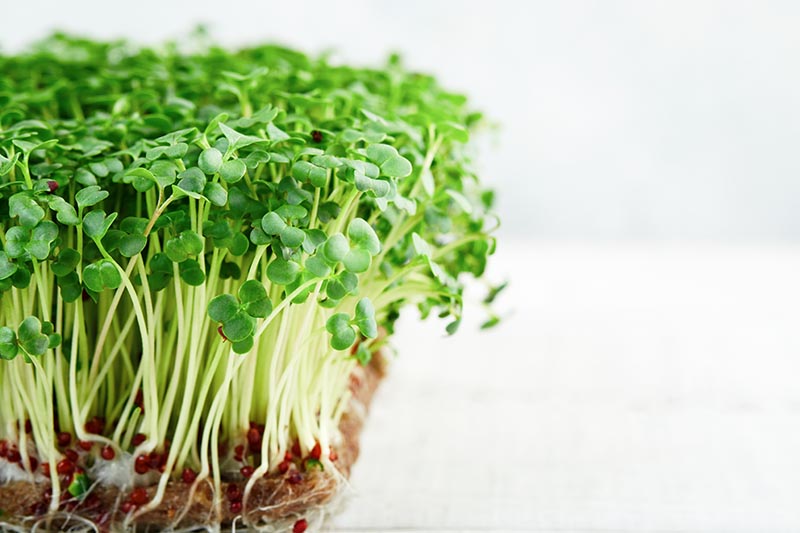
| Family: | Brassicaceae |
| Germination Time: | 2–3 days |
| Harvest Time: | 10–14 days |
There are many ways to enjoy a head of broccoli including roasting, pan frying, and on a salad. But did you know that you can delight in eating broccoli microgreens?
There are just as many nutritional benefits that your body appreciates with microgreens. These are full of essential nutrients that your body requires like phosphorus, magnesium, zinc, iron, copper, and vitamins A, B, C, E, and K.
3. Cress Microgreens
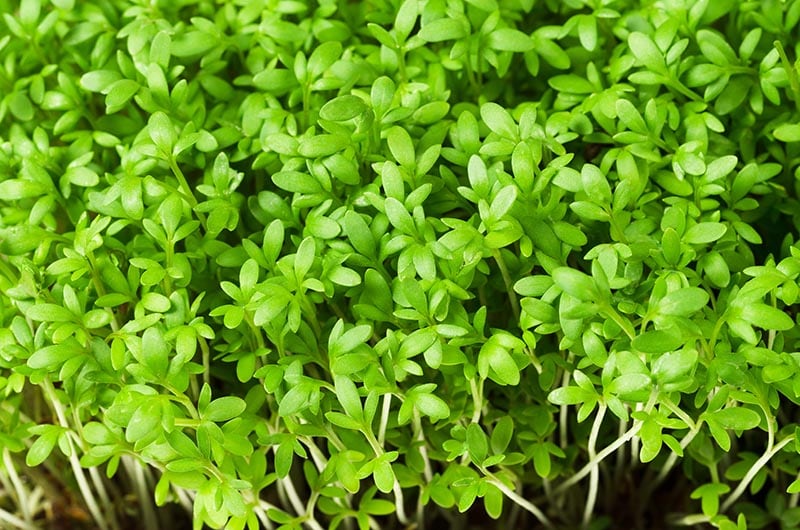
| Family: | Brassicaceae |
| Germination Time: | 1–2 days |
| Harvest Time: | 10–25 days |
Another healthy and delicious microgreen that you can grow at home is cress. This vegetable is quite popular across the world. Many people love growing it in hydroponic setups, and it takes a short time to harvest.
Not only are Cress microgreens delicious, but they also carry loads of essential nutrients. Cress has loads of water content and dietary fiber. On top of that, you benefit from vitamins A, C, and K, manganese, magnesium, and potassium. Cress microgreens are great when you want to enjoy a low-calorie meal.
4. Mesclun Microgreens
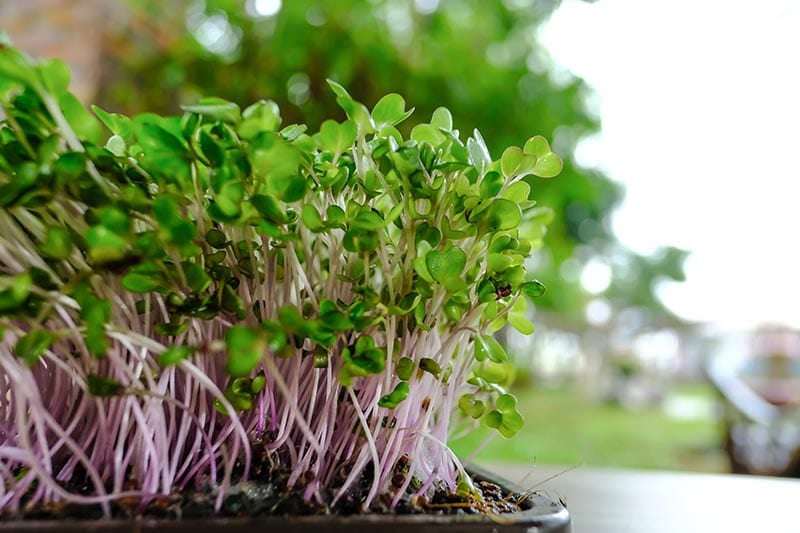
| Family: | Asteraceae |
| Germination Time: | 3–4 days |
| Harvest Time: | 14–16 days |
Do you want to enjoy a healthy baby green salad at home? How about you plant some mesclun microgreens? Mesclun is an assortment of salad greens that are easy to grow at home. Plus, they are loaded with essential nutrients.
All you need is to purchase some mesclun seeds, sow, water, and enjoy your microgreens germinating. These are loaded with essential nutrients such as calcium, iron, and vitamins A and C. One cup of mesclun microgreens has 0.7 grams of dietary fiber and 0.7 grams of protein. Ensure to plant the microgreens in nutritious soil and allow full sun exposure.
5. Arugula Microgreens

| Family: | Brassicaceae |
| Germination Time: | 7–10 days |
| Harvest Time: | 10–14 days |
If you want a fast-growing microgreen, you can never go wrong with arugula. This is a healthy, delicious, and tender vegetable. It has a tangy flavor that goes well with salads, and it can be a great topping for pizzas.
A cup of arugula microgreens gives your body 0.516 grams of protein and 0.132 grams of fat. This vegetable is also rich in folate, magnesium, iron, potassium, calcium, vitamin K and C. Having a high percentage of vitamin K and calcium makes arugula microgreens excellent for bone development and health.
6. Amaranth Microgreens

| Family: | Brassicaceae |
| Germination Time: | 7–10 days |
| Harvest Time: | 10–14 days |
Amaranth microgreens are also easy and perfect for growing at home. All you need is to pick out the seed variety to grow and get a germination medium. After sprouting, the amaranth greens will require full sun exposure until harvest time.
These microgreens are an excellent source of protein. There are 2.5 grams of protein in one cup of amaranth microgreens. Plus, the same amount has 23 calories and 4 grams of carbs, as well as vitamins A, C, and K, potassium, zinc, folate, calcium, manganese, iron, magnesium, and phosphorus.
7. Pea Microgreens
| Family: | Fabaceae |
| Germination Time: | 2–3 days |
| Harvest Time: | 8–14 days |
The most common way to eat peas is by harvesting the seeds in mature pods. But did you know you can also eat pea microgreens? All you need is to germinate the seeds and time the harvest to enjoy delicious microgreens.
Pea microgreens have a similar taste to mature peas and are packed full of essential nutrients. In fact, these microgreens are an excellent source of vitamins C and A. There’s also iron, calcium, potassium, phosphorus, and sodium. One cup of pea’s microgreens has 149 calories and 10.6 grams of protein.
8. Asparagus Microgreens
| Family: | Asparagaceae |
| Germination Time: | 21 days |
| Harvest Time: | 24–30 days |
Adding some Asparagus to your meals has immense nutritional benefits. While you can always enjoy mature asparagus, another excellent option are microgreens. Asparagus microgreens are perfect to grow at home even with limited growing space.
These microgreens are tasty, but they take time to germinate. However, once the microgreens are ready for harvest, you can enjoy lots of healthy nutrients. One cup of asparagus microgreens contains 20 calories, 2.2 grams of protein, and 0.2 grams of fat. There are also vitamins C, A, E, and K, plus phosphorus, folate, and potassium.
9. Red Cabbage Microgreens
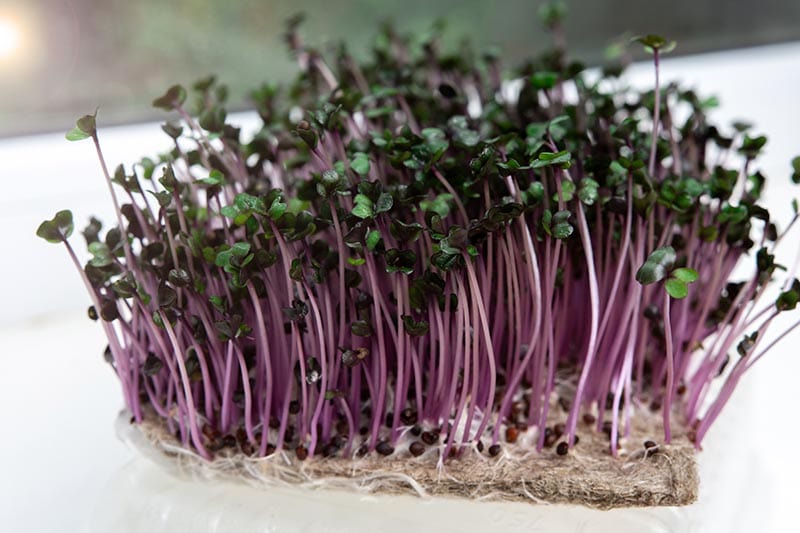
| Family: | Brassicaceae |
| Germination Time: | 7–12 days |
| Harvest Time: | 10–14 days |
Did you know that you can enjoy red cabbage at a tender age? This means harvesting red cabbage seedlings a short period after germination as microgreens.
Such delicious microgreens are packed with vitamins C and K, sulfur, beta-carotene, potassium, calcium, magnesium, and iodine. Elements like beta carotene are crucial for eye health, boosting immune function, and radiant skin. Plus, red cabbage microgreens are good for healthy bowel movements.
10. Radish Microgreens
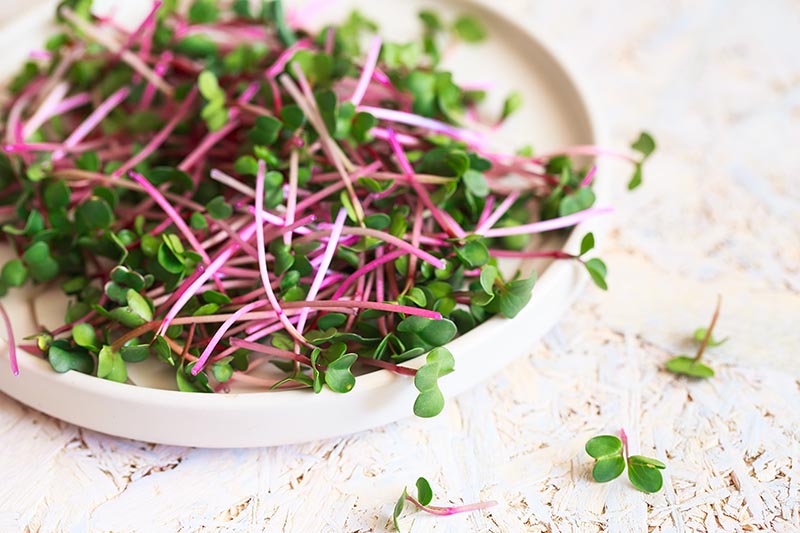
| Family: | Brassicaceae |
| Germination Time: | 3 days |
| Harvest Time: | 3–7 days |
Are you looking for easy and quick microgreens to grow at home? A good example is radishes that come in numerous varieties. While mature radishes make excellent additions to recipes, it’s even better to enjoy them as microgreens.
Radish microgreens have excellent flavor and a crunchy taste excellent for salads. These are a good source of vitamins A, B, C, E, and K. They are also rich in zinc, calcium, phosphorus, potassium, iron, and zinc. The body will thank you since these all benefit the immune system immensely.
11. Carrot Microgreens
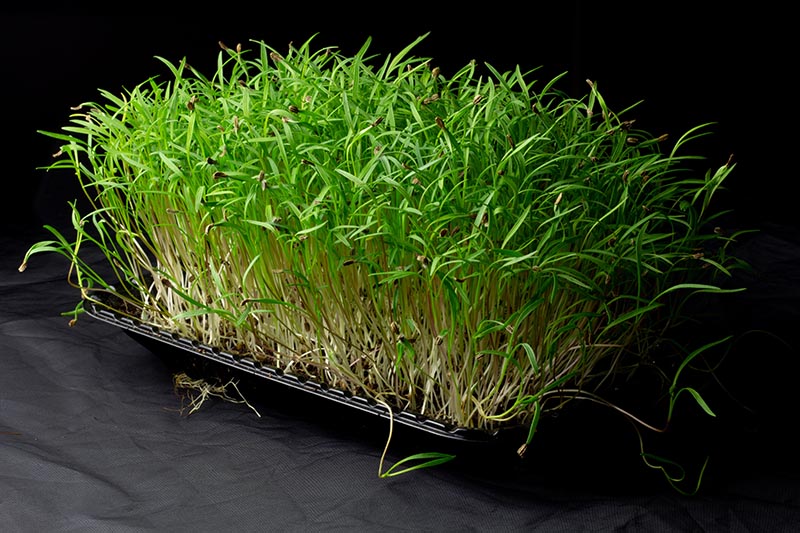
| Family: | Daucus |
| Germination Time: | 3–7 days |
| Harvest Time: | 15–25 days |
Mature carrots are delicious and packed with essential nutrients like beta-carotene. However, you can also enjoy them as microgreens. The good news is carrot microgreens are easy to grow at home. They have a mild flavor and are simple to harvest when ready.
Carrot microgreens take longer to be ready for harvest compared to most other types. You will get vitamins A, B6, K, and C. They’re also rich in beta-carotene, magnesium, calcium, iron, manganese, and potassium. A cup of carrot microgreens only has 90 calories, 0 grams of fat, and loads of antioxidants.
12. Chervil Microgreens
| Family: | Umbellifers |
| Germination Time: | 2–3 days |
| Harvest Time: | 12–14 days |
Culinary dishes require different herbs in order to get that amazing taste and flavor. One example of a tasty popular herb is chervil. Not only can you add it to different dishes, but chervil is also good as a microgreen. It’s best to enjoy it when freshly cut, so you can grow some in your microgreen garden at home.
Chervil microgreens are flavorful and robust with slender stems. These are good because of their high nutritional value. A cup of chervil microgreens contains loads of vitamins, A, E, and C. There’s also calcium, iron, potassium, copper, and zinc. Chervil microgreens require full sun exposure once the seeds germinate.
13. Dill Microgreens

| Family: | Umbellifers |
| Germination Time: | 4–5 days |
| Harvest Time: | 12–15 days |
Dill is among the best herbs to add to different dishes that require a zesty flavor. However, you can also enjoy it as a microgreen. Not only does it bring loads of flavor to a salad, but it also adds that delightful crunchiness.
Growing dill microgreens is a great idea for your home garden. These are rich in different nutrients including vitamins A, B, C, E, and K. Also, your body benefits from zinc, potassium, calcium, and iron. All you require is a small space indoors if you want to grow dill microgreens in a pot or container.
14. Kale Microgreens

| Family: | Brassicaceae |
| Germination Time: | 4–5 days |
| Harvest Time: | 8–12 days |
Dark leafy greens like kale are healthy and great to eat at home. Plus, you can always add some to your smoothie. The good news is you can grow kale microgreens at home easily. After harvesting, these are easy to store- you can enjoy them for a week or two.
Kale microgreens have a nutty and strong flavor. They are great to mix in a salad with other microgreens growing in your indoor garden. A cup of kale microgreens is packed with vitamins B6, A, K, and C. There’s also copper, calcium, potassium, magnesium, potassium, fiber, and antioxidants.
15. Lettuce Microgreens

| Family: | Asteraceae |
| Germination Time: | 2–3 days |
| Harvest Time: | 8–20 days |
Did you know it’s possible to sprout some lettuce seeds at home and harvest microgreens? All it takes is a good growing medium, moisture, lettuce seeds, and a growing container. Lettuce microgreens germinate fast and are ready to harvest within a short duration.
These are excellent sources of essential nutrients, such as selenium, iron, manganese, zinc, potassium, and calcium. They are also a great source of vitamins A, B6, C, K, and D. Eating lettuce microgreens benefits the body by boosting bone and eye health.
16. Mint Microgreens
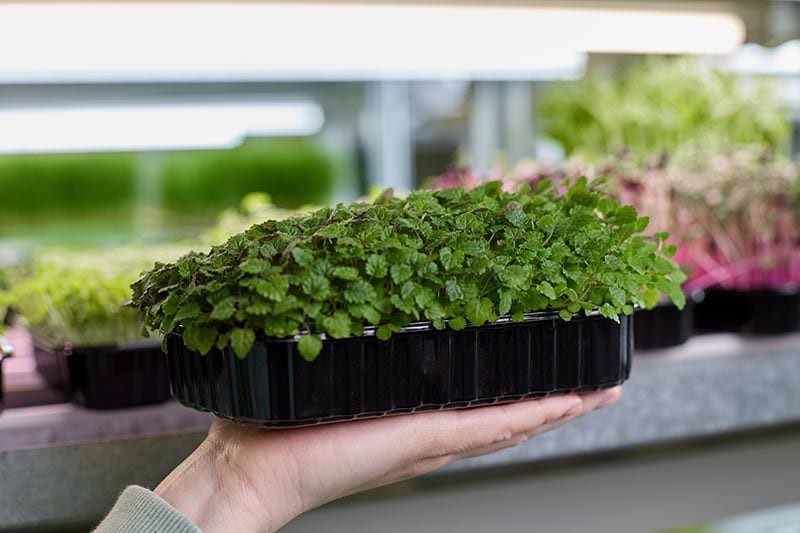
| Family: | Lamiaceae |
| Germination Time: | 7–10 days |
| Harvest Time: | 10–14 days |
Mint microgreens or micro mint require harvesting when the plant has two to four tiny leaves. At this stage, the mint plants are delicate and tender. However, you still enjoy the great aroma and herbaceous taste of mint. The entire microgreen has a refreshing aftertaste and cooling menthol effect.
These microgreens are great to add to salads, for garnishing dishes and preparing drinks. They are packed with essential nutrients and only 6 calories per 100 grams. The body benefits from vitamin A, folate, iron, manganese, and some fiber.
17. Onion Microgreens

| Family: | Amaryllidaceae |
| Germination Time: | 3–4 days |
| Harvest Time: | 12–21 days |
Onions are a staple root vegetable with numerous uses at home. So, it makes sense to have some growing at home in your indoor or outdoor garden. While whole onions are excellent, you can also grow microgreens. These still have the same garlic taste and are edible.
Onion microgreens grow from seeds to tall skinny greens. A handful is rich in vitamins A, C, E, and B. Also, these are packed with different minerals including potassium, iron, calcium, zinc, and magnesium. A growing tray with soil can be a great place to germinate onion microgreens indoors.
18. Beetroot Microgreens
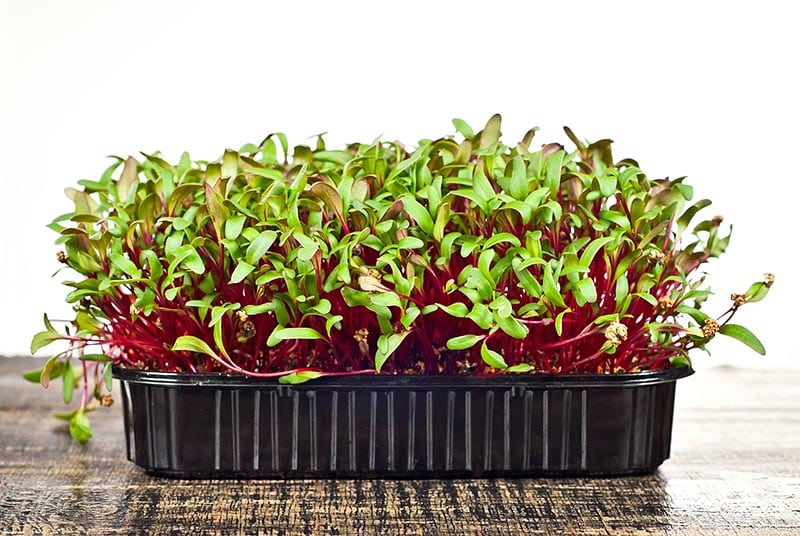
| Family: | Amaranthaceae |
| Germination Time: | 3–5 days |
| Harvest Time: | 10–20 days |
Beetroot microgreens take a few days to germinate and are simple to grow. There are excellent seed starter kits that you can use to grow these microgreens at home. Once ready for harvest, you can eat and store the rest in the refrigerator.
The microgreens are tasty and packed with healthy nutrients like iron, calcium, copper, potassium, magnesium, and vitamins A, B, C, E, and K.
Conclusion
It doesn’t take long to grow different kinds of microgreens at home. Some take a few days to germinate, while there are other seeds that take more time. Still, you won’t miss harvesting some excellent microgreens to make a salad or add to different dishes.
Microgreens are rich in nutrients like vitamins and minerals. Often, they taste like mature plants, and you can mix them together to make a healthy microgreen salad. All you need is a small indoor space that gets ample bright light to grow microgreens at home.
Featured Image Credit: DamianH3, Pixabay
Contents


